Contract and Negligence in Business: A Comprehensive Report
VerifiedAdded on 2020/02/14
|12
|4190
|365
Report
AI Summary
This report provides a comprehensive analysis of contract law and negligence within a business context. It begins with an introduction to contracts, defining them as legally binding agreements formed through offer, acceptance, and consideration. The report then details the essential elements for a valid contract, including offer and acceptance, intention to create legal relations, certainty, consideration, legal capacity, and completeness. Different types of contracts, such as unilateral and bilateral contracts, contracts under seal, written and verbal contracts, and face-to-face and distance contracts, are examined along with their respective impacts. The report further explores contract terms, including express and implied terms, conditions, warranties, innominate terms, and exclusion clauses. The analysis extends to case studies, applying contract principles to scenarios involving advertisements, challenges, and sales agreements. The report discusses the application of contract elements, implied terms, and exclusion clauses in different situations, including claims for compensation and damages. The report also examines the legal implications of negligence, the impact of exclusion clauses, and the remedies available in case of breach of contract.
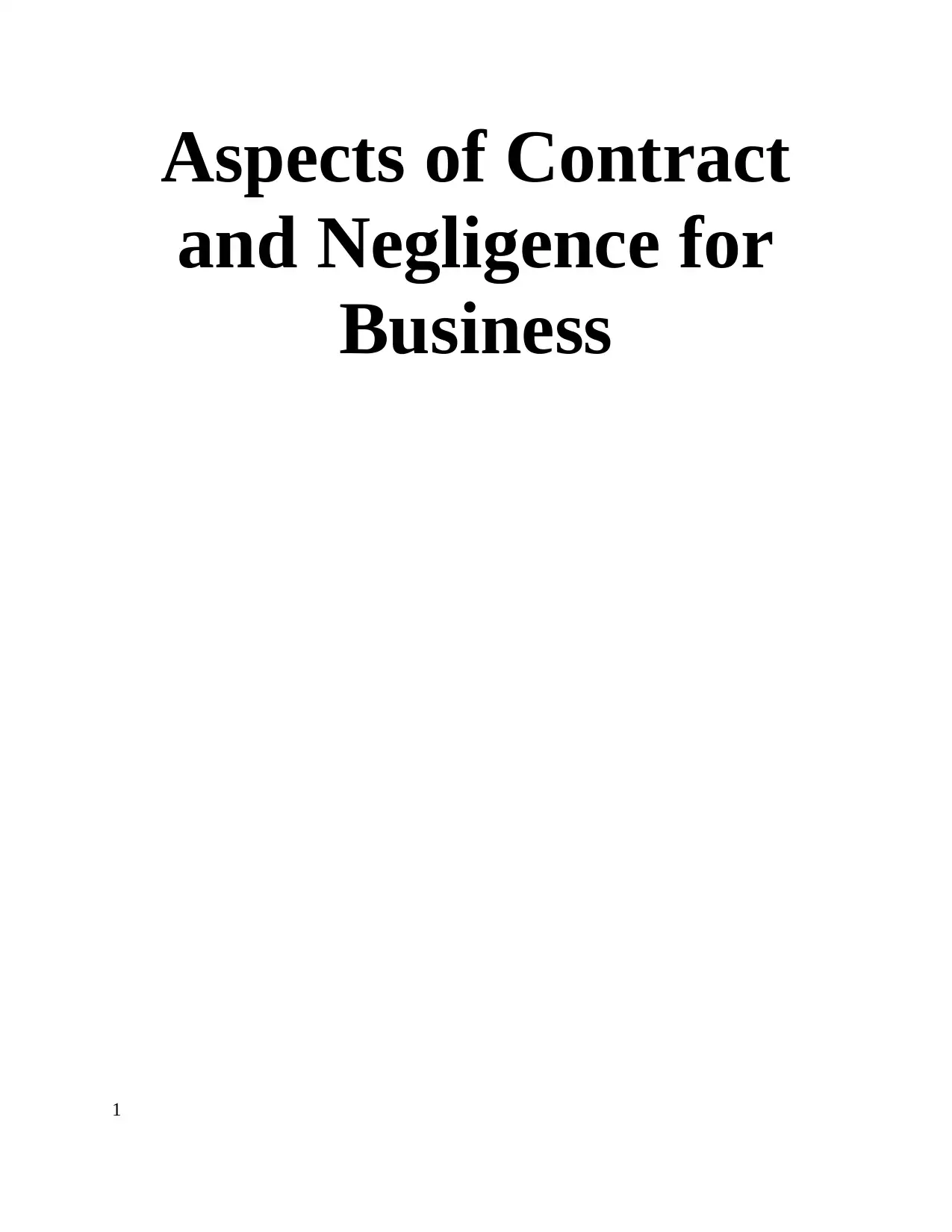
Aspects of Contract
and Negligence for
Business
1
and Negligence for
Business
1
Paraphrase This Document
Need a fresh take? Get an instant paraphrase of this document with our AI Paraphraser
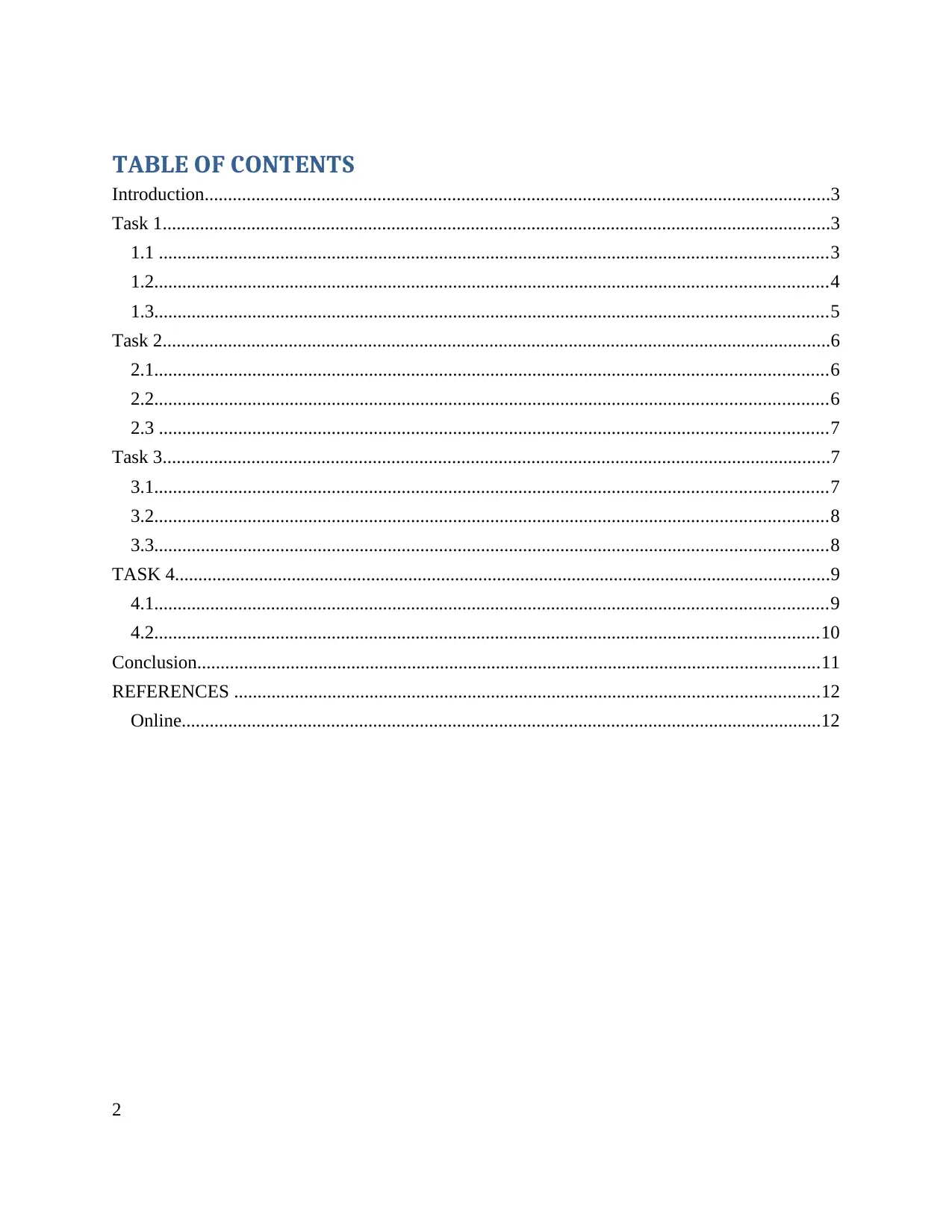
TABLE OF CONTENTS
Introduction......................................................................................................................................3
Task 1...............................................................................................................................................3
1.1 ...............................................................................................................................................3
1.2................................................................................................................................................4
1.3................................................................................................................................................5
Task 2...............................................................................................................................................6
2.1................................................................................................................................................6
2.2................................................................................................................................................6
2.3 ...............................................................................................................................................7
Task 3...............................................................................................................................................7
3.1................................................................................................................................................7
3.2................................................................................................................................................8
3.3................................................................................................................................................8
TASK 4............................................................................................................................................9
4.1................................................................................................................................................9
4.2..............................................................................................................................................10
Conclusion.....................................................................................................................................11
REFERENCES .............................................................................................................................12
Online.........................................................................................................................................12
2
Introduction......................................................................................................................................3
Task 1...............................................................................................................................................3
1.1 ...............................................................................................................................................3
1.2................................................................................................................................................4
1.3................................................................................................................................................5
Task 2...............................................................................................................................................6
2.1................................................................................................................................................6
2.2................................................................................................................................................6
2.3 ...............................................................................................................................................7
Task 3...............................................................................................................................................7
3.1................................................................................................................................................7
3.2................................................................................................................................................8
3.3................................................................................................................................................8
TASK 4............................................................................................................................................9
4.1................................................................................................................................................9
4.2..............................................................................................................................................10
Conclusion.....................................................................................................................................11
REFERENCES .............................................................................................................................12
Online.........................................................................................................................................12
2
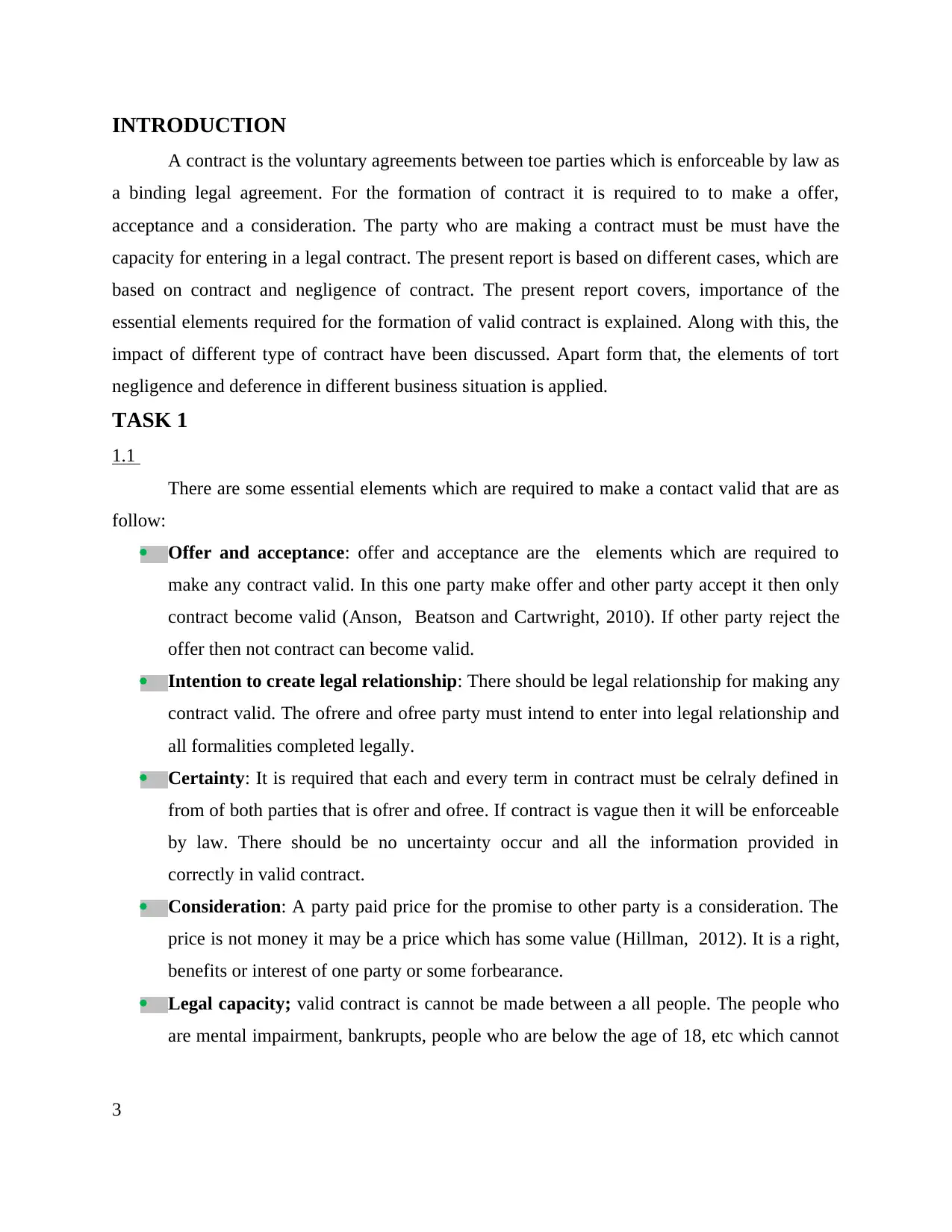
INTRODUCTION
A contract is the voluntary agreements between toe parties which is enforceable by law as
a binding legal agreement. For the formation of contract it is required to to make a offer,
acceptance and a consideration. The party who are making a contract must be must have the
capacity for entering in a legal contract. The present report is based on different cases, which are
based on contract and negligence of contract. The present report covers, importance of the
essential elements required for the formation of valid contract is explained. Along with this, the
impact of different type of contract have been discussed. Apart form that, the elements of tort
negligence and deference in different business situation is applied.
TASK 1
1.1
There are some essential elements which are required to make a contact valid that are as
follow:
Offer and acceptance: offer and acceptance are the elements which are required to
make any contract valid. In this one party make offer and other party accept it then only
contract become valid (Anson, Beatson and Cartwright, 2010). If other party reject the
offer then not contract can become valid.
Intention to create legal relationship: There should be legal relationship for making any
contract valid. The ofrere and ofree party must intend to enter into legal relationship and
all formalities completed legally.
Certainty: It is required that each and every term in contract must be celraly defined in
from of both parties that is ofrer and ofree. If contract is vague then it will be enforceable
by law. There should be no uncertainty occur and all the information provided in
correctly in valid contract.
Consideration: A party paid price for the promise to other party is a consideration. The
price is not money it may be a price which has some value (Hillman, 2012). It is a right,
benefits or interest of one party or some forbearance.
Legal capacity; valid contract is cannot be made between a all people. The people who
are mental impairment, bankrupts, people who are below the age of 18, etc which cannot
3
A contract is the voluntary agreements between toe parties which is enforceable by law as
a binding legal agreement. For the formation of contract it is required to to make a offer,
acceptance and a consideration. The party who are making a contract must be must have the
capacity for entering in a legal contract. The present report is based on different cases, which are
based on contract and negligence of contract. The present report covers, importance of the
essential elements required for the formation of valid contract is explained. Along with this, the
impact of different type of contract have been discussed. Apart form that, the elements of tort
negligence and deference in different business situation is applied.
TASK 1
1.1
There are some essential elements which are required to make a contact valid that are as
follow:
Offer and acceptance: offer and acceptance are the elements which are required to
make any contract valid. In this one party make offer and other party accept it then only
contract become valid (Anson, Beatson and Cartwright, 2010). If other party reject the
offer then not contract can become valid.
Intention to create legal relationship: There should be legal relationship for making any
contract valid. The ofrere and ofree party must intend to enter into legal relationship and
all formalities completed legally.
Certainty: It is required that each and every term in contract must be celraly defined in
from of both parties that is ofrer and ofree. If contract is vague then it will be enforceable
by law. There should be no uncertainty occur and all the information provided in
correctly in valid contract.
Consideration: A party paid price for the promise to other party is a consideration. The
price is not money it may be a price which has some value (Hillman, 2012). It is a right,
benefits or interest of one party or some forbearance.
Legal capacity; valid contract is cannot be made between a all people. The people who
are mental impairment, bankrupts, people who are below the age of 18, etc which cannot
3
⊘ This is a preview!⊘
Do you want full access?
Subscribe today to unlock all pages.

Trusted by 1+ million students worldwide
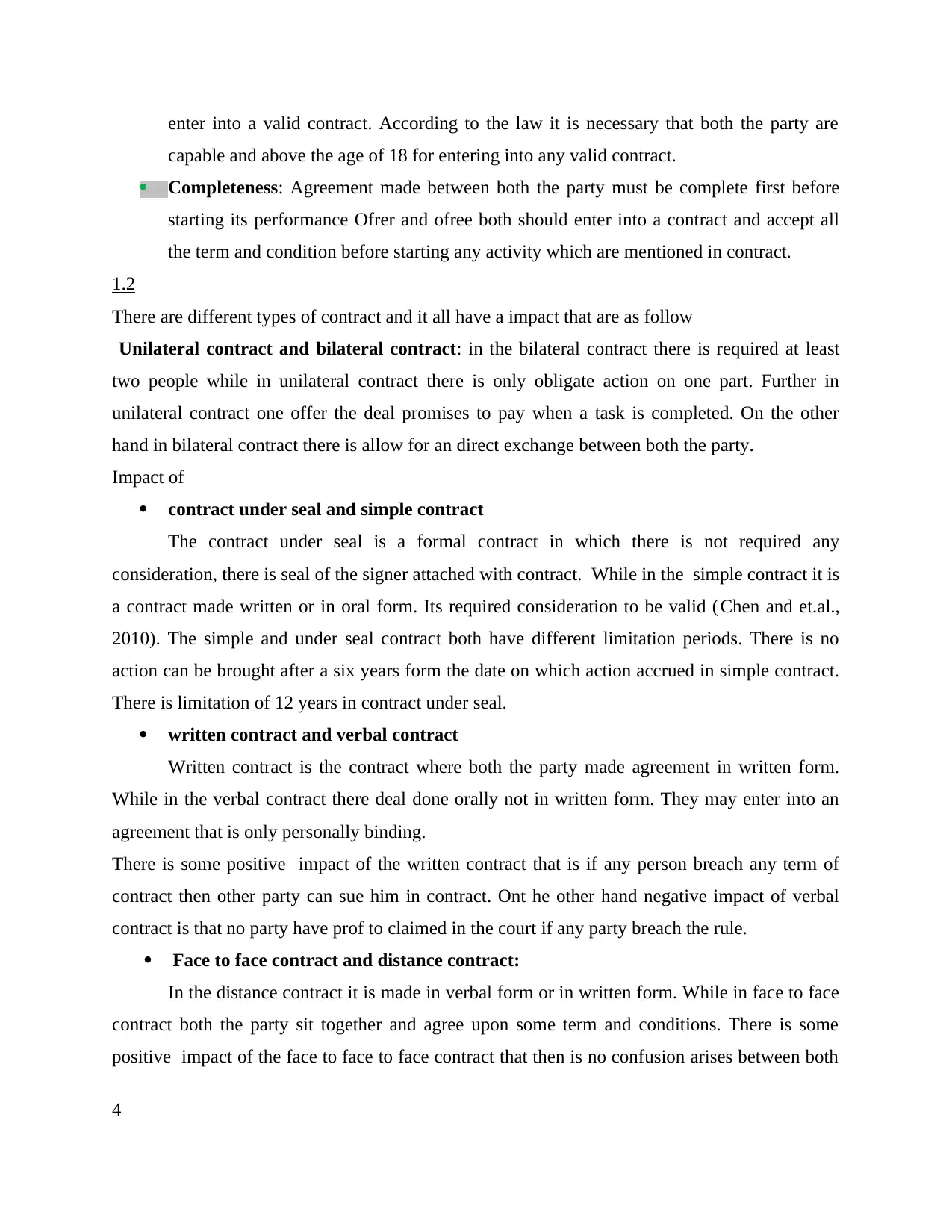
enter into a valid contract. According to the law it is necessary that both the party are
capable and above the age of 18 for entering into any valid contract.
Completeness: Agreement made between both the party must be complete first before
starting its performance Ofrer and ofree both should enter into a contract and accept all
the term and condition before starting any activity which are mentioned in contract.
1.2
There are different types of contract and it all have a impact that are as follow
Unilateral contract and bilateral contract: in the bilateral contract there is required at least
two people while in unilateral contract there is only obligate action on one part. Further in
unilateral contract one offer the deal promises to pay when a task is completed. On the other
hand in bilateral contract there is allow for an direct exchange between both the party.
Impact of
contract under seal and simple contract
The contract under seal is a formal contract in which there is not required any
consideration, there is seal of the signer attached with contract. While in the simple contract it is
a contract made written or in oral form. Its required consideration to be valid (Chen and et.al.,
2010). The simple and under seal contract both have different limitation periods. There is no
action can be brought after a six years form the date on which action accrued in simple contract.
There is limitation of 12 years in contract under seal.
written contract and verbal contract
Written contract is the contract where both the party made agreement in written form.
While in the verbal contract there deal done orally not in written form. They may enter into an
agreement that is only personally binding.
There is some positive impact of the written contract that is if any person breach any term of
contract then other party can sue him in contract. Ont he other hand negative impact of verbal
contract is that no party have prof to claimed in the court if any party breach the rule.
Face to face contract and distance contract:
In the distance contract it is made in verbal form or in written form. While in face to face
contract both the party sit together and agree upon some term and conditions. There is some
positive impact of the face to face to face contract that then is no confusion arises between both
4
capable and above the age of 18 for entering into any valid contract.
Completeness: Agreement made between both the party must be complete first before
starting its performance Ofrer and ofree both should enter into a contract and accept all
the term and condition before starting any activity which are mentioned in contract.
1.2
There are different types of contract and it all have a impact that are as follow
Unilateral contract and bilateral contract: in the bilateral contract there is required at least
two people while in unilateral contract there is only obligate action on one part. Further in
unilateral contract one offer the deal promises to pay when a task is completed. On the other
hand in bilateral contract there is allow for an direct exchange between both the party.
Impact of
contract under seal and simple contract
The contract under seal is a formal contract in which there is not required any
consideration, there is seal of the signer attached with contract. While in the simple contract it is
a contract made written or in oral form. Its required consideration to be valid (Chen and et.al.,
2010). The simple and under seal contract both have different limitation periods. There is no
action can be brought after a six years form the date on which action accrued in simple contract.
There is limitation of 12 years in contract under seal.
written contract and verbal contract
Written contract is the contract where both the party made agreement in written form.
While in the verbal contract there deal done orally not in written form. They may enter into an
agreement that is only personally binding.
There is some positive impact of the written contract that is if any person breach any term of
contract then other party can sue him in contract. Ont he other hand negative impact of verbal
contract is that no party have prof to claimed in the court if any party breach the rule.
Face to face contract and distance contract:
In the distance contract it is made in verbal form or in written form. While in face to face
contract both the party sit together and agree upon some term and conditions. There is some
positive impact of the face to face to face contract that then is no confusion arises between both
4
Paraphrase This Document
Need a fresh take? Get an instant paraphrase of this document with our AI Paraphraser

the parties and if arises then it solved on the spot. There is some negative impact of distance
contract that is it may create any confusion and there if any delay done in contract then it may
lead to rejection.
1.3
Express term : it is a contract which is made by word of spoken or in written form . It
should be agreed by both the party. For example if john sell car to Abel and it ready to
purchase car at ten thousand then it s a express contract made by both the party. In this
contract john express its deal in front of Abel and it ready to accept it orally.
Implied terms : It is agreement created by actions of the parties involved, but not in
written or spoken form (Liu, Cheng and Xie, 2012). it means that this contract assumed
to have been drawn and it came under the law. Not in written form
Condition; condition is the important term of contract which goes to its root. If any party
breached the condition then innocent party can sue it in court and can claim the damages.
warranties :it not important term in contract as if any party break any rule of contract
then other party cannot breach the contract. However it can claim the damages form the
other party.
In the case of slick car sales ltd. Paul visit to the showroom of slick care and want to
purchase a car who's price is £ 3,995, the sales men tell him that it is a 1994 mondeo
which has it has only one owner (Hou, Zeng and Zhao, 2010). Paul sign a agreement of
sale in which describes a 1994 ford Mondeo. In this case Paul is unsure that these
statement represent traders puff comes in condition or warranty. It also want to know that
implied terms in the agreement and remedies available if these statement turn to be false.
Innominate terms; The Innominate term lies between condition and warranties. This
term use less in the contract and its affect is also less. This term looks affect to breach
and question whether the innocent party breach deprived or there is whole benefit to the
contract.
Exclusion clauses these are the clause in a contract in which party is free from liability of
performing the term contract. In a contract there is certain condition in which party not
held the liability for preforming a it in the terms in contract. But by the both parties
clause should be accepted.
5
contract that is it may create any confusion and there if any delay done in contract then it may
lead to rejection.
1.3
Express term : it is a contract which is made by word of spoken or in written form . It
should be agreed by both the party. For example if john sell car to Abel and it ready to
purchase car at ten thousand then it s a express contract made by both the party. In this
contract john express its deal in front of Abel and it ready to accept it orally.
Implied terms : It is agreement created by actions of the parties involved, but not in
written or spoken form (Liu, Cheng and Xie, 2012). it means that this contract assumed
to have been drawn and it came under the law. Not in written form
Condition; condition is the important term of contract which goes to its root. If any party
breached the condition then innocent party can sue it in court and can claim the damages.
warranties :it not important term in contract as if any party break any rule of contract
then other party cannot breach the contract. However it can claim the damages form the
other party.
In the case of slick car sales ltd. Paul visit to the showroom of slick care and want to
purchase a car who's price is £ 3,995, the sales men tell him that it is a 1994 mondeo
which has it has only one owner (Hou, Zeng and Zhao, 2010). Paul sign a agreement of
sale in which describes a 1994 ford Mondeo. In this case Paul is unsure that these
statement represent traders puff comes in condition or warranty. It also want to know that
implied terms in the agreement and remedies available if these statement turn to be false.
Innominate terms; The Innominate term lies between condition and warranties. This
term use less in the contract and its affect is also less. This term looks affect to breach
and question whether the innocent party breach deprived or there is whole benefit to the
contract.
Exclusion clauses these are the clause in a contract in which party is free from liability of
performing the term contract. In a contract there is certain condition in which party not
held the liability for preforming a it in the terms in contract. But by the both parties
clause should be accepted.
5
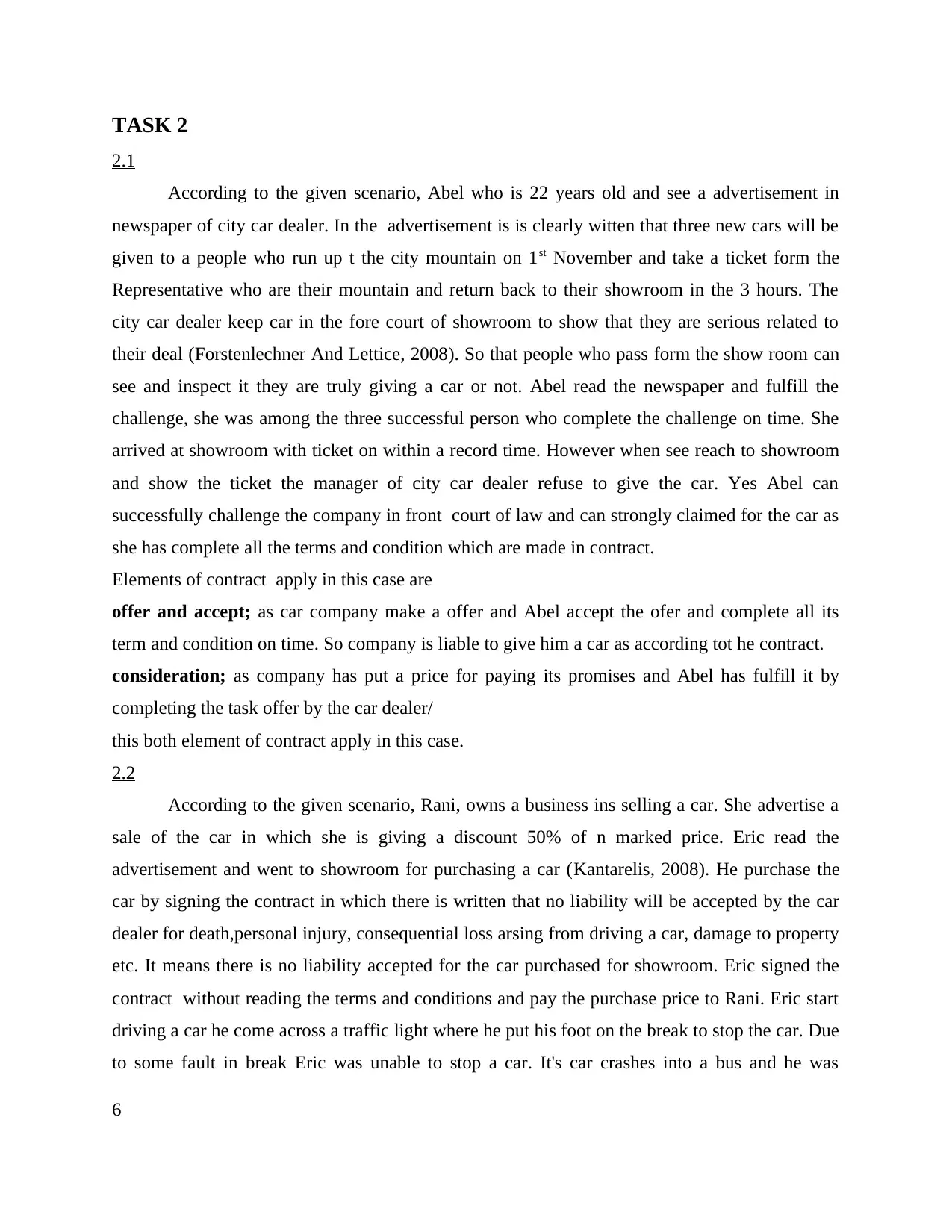
TASK 2
2.1
According to the given scenario, Abel who is 22 years old and see a advertisement in
newspaper of city car dealer. In the advertisement is is clearly witten that three new cars will be
given to a people who run up t the city mountain on 1st November and take a ticket form the
Representative who are their mountain and return back to their showroom in the 3 hours. The
city car dealer keep car in the fore court of showroom to show that they are serious related to
their deal (Forstenlechner And Lettice, 2008). So that people who pass form the show room can
see and inspect it they are truly giving a car or not. Abel read the newspaper and fulfill the
challenge, she was among the three successful person who complete the challenge on time. She
arrived at showroom with ticket on within a record time. However when see reach to showroom
and show the ticket the manager of city car dealer refuse to give the car. Yes Abel can
successfully challenge the company in front court of law and can strongly claimed for the car as
she has complete all the terms and condition which are made in contract.
Elements of contract apply in this case are
offer and accept; as car company make a offer and Abel accept the ofer and complete all its
term and condition on time. So company is liable to give him a car as according tot he contract.
consideration; as company has put a price for paying its promises and Abel has fulfill it by
completing the task offer by the car dealer/
this both element of contract apply in this case.
2.2
According to the given scenario, Rani, owns a business ins selling a car. She advertise a
sale of the car in which she is giving a discount 50% of n marked price. Eric read the
advertisement and went to showroom for purchasing a car (Kantarelis, 2008). He purchase the
car by signing the contract in which there is written that no liability will be accepted by the car
dealer for death,personal injury, consequential loss arsing from driving a car, damage to property
etc. It means there is no liability accepted for the car purchased for showroom. Eric signed the
contract without reading the terms and conditions and pay the purchase price to Rani. Eric start
driving a car he come across a traffic light where he put his foot on the break to stop the car. Due
to some fault in break Eric was unable to stop a car. It's car crashes into a bus and he was
6
2.1
According to the given scenario, Abel who is 22 years old and see a advertisement in
newspaper of city car dealer. In the advertisement is is clearly witten that three new cars will be
given to a people who run up t the city mountain on 1st November and take a ticket form the
Representative who are their mountain and return back to their showroom in the 3 hours. The
city car dealer keep car in the fore court of showroom to show that they are serious related to
their deal (Forstenlechner And Lettice, 2008). So that people who pass form the show room can
see and inspect it they are truly giving a car or not. Abel read the newspaper and fulfill the
challenge, she was among the three successful person who complete the challenge on time. She
arrived at showroom with ticket on within a record time. However when see reach to showroom
and show the ticket the manager of city car dealer refuse to give the car. Yes Abel can
successfully challenge the company in front court of law and can strongly claimed for the car as
she has complete all the terms and condition which are made in contract.
Elements of contract apply in this case are
offer and accept; as car company make a offer and Abel accept the ofer and complete all its
term and condition on time. So company is liable to give him a car as according tot he contract.
consideration; as company has put a price for paying its promises and Abel has fulfill it by
completing the task offer by the car dealer/
this both element of contract apply in this case.
2.2
According to the given scenario, Rani, owns a business ins selling a car. She advertise a
sale of the car in which she is giving a discount 50% of n marked price. Eric read the
advertisement and went to showroom for purchasing a car (Kantarelis, 2008). He purchase the
car by signing the contract in which there is written that no liability will be accepted by the car
dealer for death,personal injury, consequential loss arsing from driving a car, damage to property
etc. It means there is no liability accepted for the car purchased for showroom. Eric signed the
contract without reading the terms and conditions and pay the purchase price to Rani. Eric start
driving a car he come across a traffic light where he put his foot on the break to stop the car. Due
to some fault in break Eric was unable to stop a car. It's car crashes into a bus and he was
6
⊘ This is a preview!⊘
Do you want full access?
Subscribe today to unlock all pages.

Trusted by 1+ million students worldwide
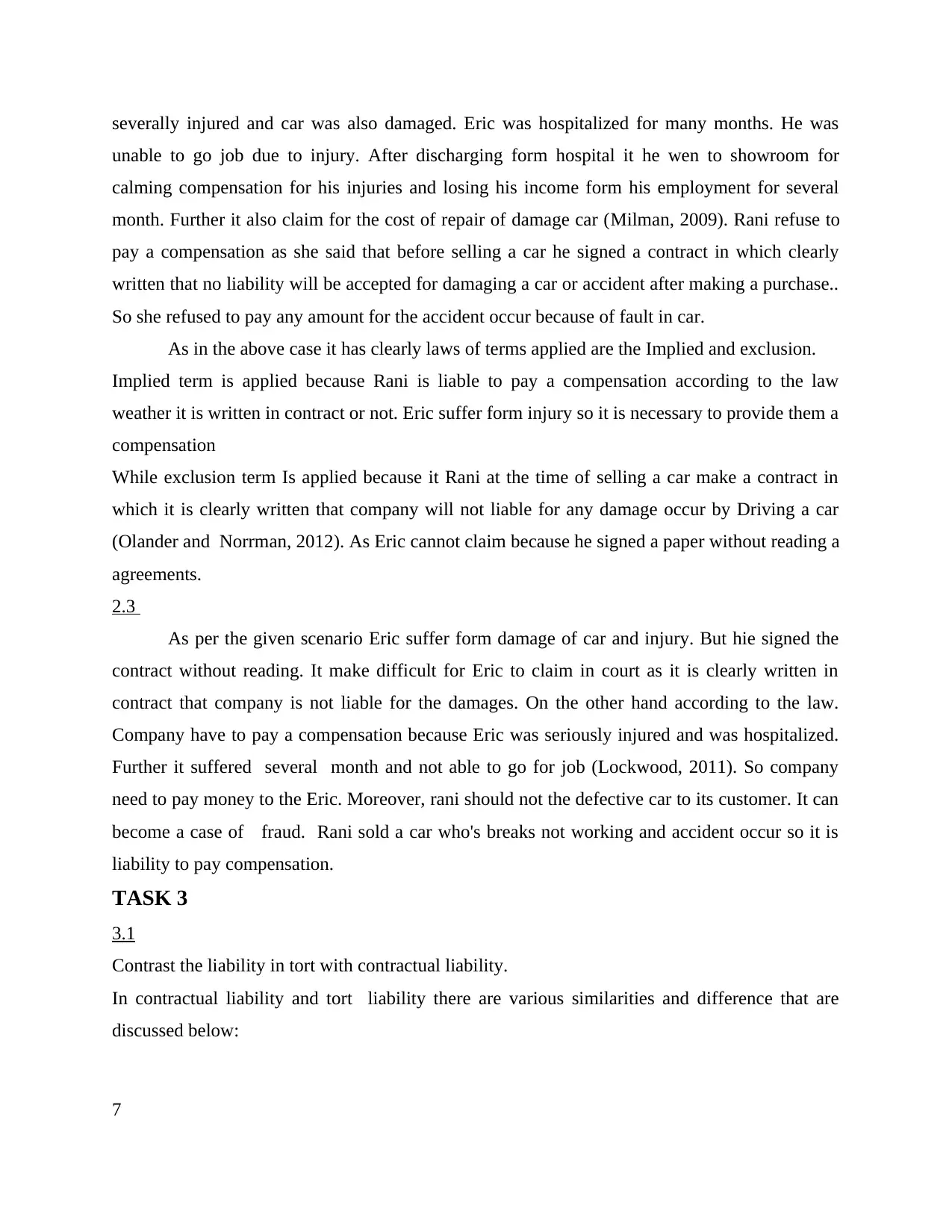
severally injured and car was also damaged. Eric was hospitalized for many months. He was
unable to go job due to injury. After discharging form hospital it he wen to showroom for
calming compensation for his injuries and losing his income form his employment for several
month. Further it also claim for the cost of repair of damage car (Milman, 2009). Rani refuse to
pay a compensation as she said that before selling a car he signed a contract in which clearly
written that no liability will be accepted for damaging a car or accident after making a purchase..
So she refused to pay any amount for the accident occur because of fault in car.
As in the above case it has clearly laws of terms applied are the Implied and exclusion.
Implied term is applied because Rani is liable to pay a compensation according to the law
weather it is written in contract or not. Eric suffer form injury so it is necessary to provide them a
compensation
While exclusion term Is applied because it Rani at the time of selling a car make a contract in
which it is clearly written that company will not liable for any damage occur by Driving a car
(Olander and Norrman, 2012). As Eric cannot claim because he signed a paper without reading a
agreements.
2.3
As per the given scenario Eric suffer form damage of car and injury. But hie signed the
contract without reading. It make difficult for Eric to claim in court as it is clearly written in
contract that company is not liable for the damages. On the other hand according to the law.
Company have to pay a compensation because Eric was seriously injured and was hospitalized.
Further it suffered several month and not able to go for job (Lockwood, 2011). So company
need to pay money to the Eric. Moreover, rani should not the defective car to its customer. It can
become a case of fraud. Rani sold a car who's breaks not working and accident occur so it is
liability to pay compensation.
TASK 3
3.1
Contrast the liability in tort with contractual liability.
In contractual liability and tort liability there are various similarities and difference that are
discussed below:
7
unable to go job due to injury. After discharging form hospital it he wen to showroom for
calming compensation for his injuries and losing his income form his employment for several
month. Further it also claim for the cost of repair of damage car (Milman, 2009). Rani refuse to
pay a compensation as she said that before selling a car he signed a contract in which clearly
written that no liability will be accepted for damaging a car or accident after making a purchase..
So she refused to pay any amount for the accident occur because of fault in car.
As in the above case it has clearly laws of terms applied are the Implied and exclusion.
Implied term is applied because Rani is liable to pay a compensation according to the law
weather it is written in contract or not. Eric suffer form injury so it is necessary to provide them a
compensation
While exclusion term Is applied because it Rani at the time of selling a car make a contract in
which it is clearly written that company will not liable for any damage occur by Driving a car
(Olander and Norrman, 2012). As Eric cannot claim because he signed a paper without reading a
agreements.
2.3
As per the given scenario Eric suffer form damage of car and injury. But hie signed the
contract without reading. It make difficult for Eric to claim in court as it is clearly written in
contract that company is not liable for the damages. On the other hand according to the law.
Company have to pay a compensation because Eric was seriously injured and was hospitalized.
Further it suffered several month and not able to go for job (Lockwood, 2011). So company
need to pay money to the Eric. Moreover, rani should not the defective car to its customer. It can
become a case of fraud. Rani sold a car who's breaks not working and accident occur so it is
liability to pay compensation.
TASK 3
3.1
Contrast the liability in tort with contractual liability.
In contractual liability and tort liability there are various similarities and difference that are
discussed below:
7
Paraphrase This Document
Need a fresh take? Get an instant paraphrase of this document with our AI Paraphraser
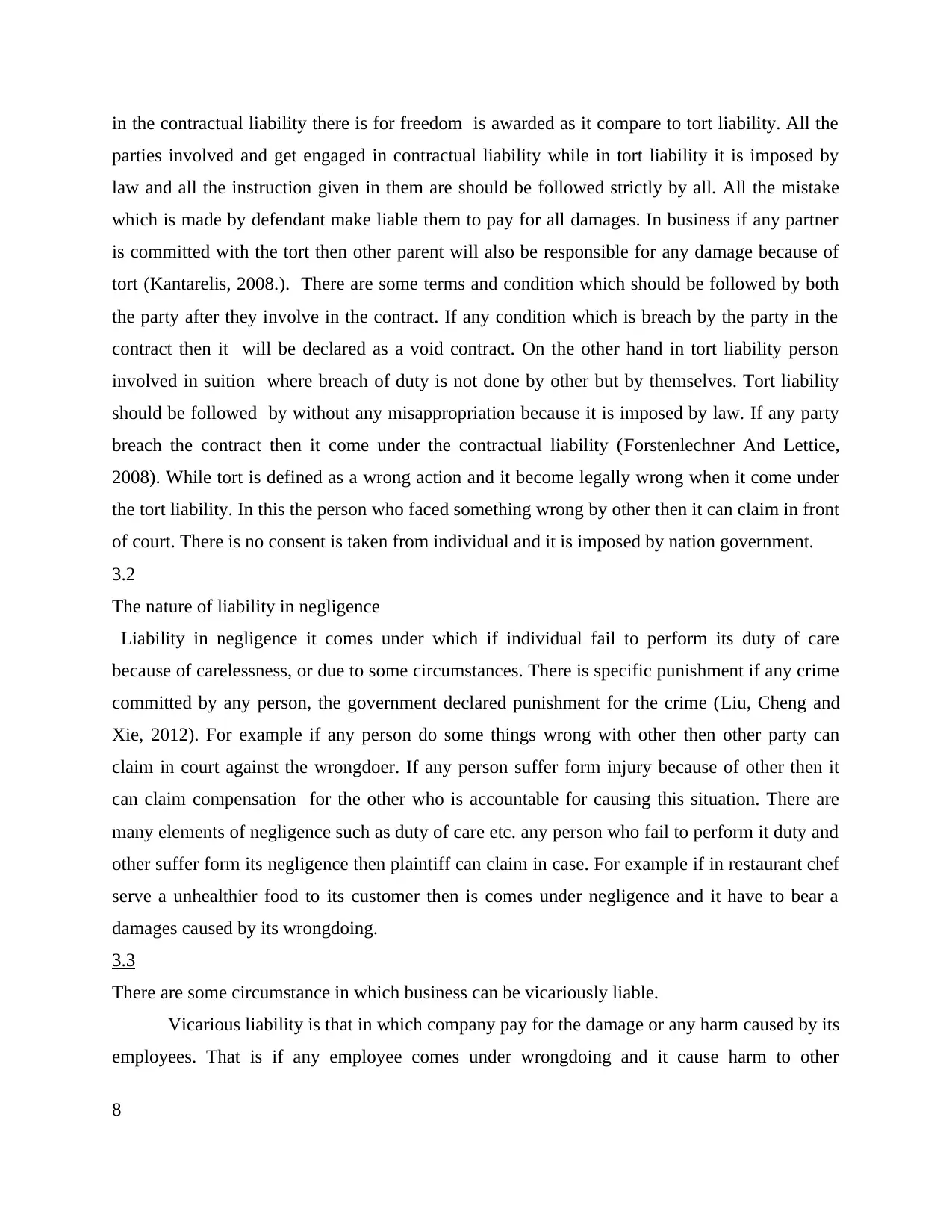
in the contractual liability there is for freedom is awarded as it compare to tort liability. All the
parties involved and get engaged in contractual liability while in tort liability it is imposed by
law and all the instruction given in them are should be followed strictly by all. All the mistake
which is made by defendant make liable them to pay for all damages. In business if any partner
is committed with the tort then other parent will also be responsible for any damage because of
tort (Kantarelis, 2008.). There are some terms and condition which should be followed by both
the party after they involve in the contract. If any condition which is breach by the party in the
contract then it will be declared as a void contract. On the other hand in tort liability person
involved in suition where breach of duty is not done by other but by themselves. Tort liability
should be followed by without any misappropriation because it is imposed by law. If any party
breach the contract then it come under the contractual liability (Forstenlechner And Lettice,
2008). While tort is defined as a wrong action and it become legally wrong when it come under
the tort liability. In this the person who faced something wrong by other then it can claim in front
of court. There is no consent is taken from individual and it is imposed by nation government.
3.2
The nature of liability in negligence
Liability in negligence it comes under which if individual fail to perform its duty of care
because of carelessness, or due to some circumstances. There is specific punishment if any crime
committed by any person, the government declared punishment for the crime (Liu, Cheng and
Xie, 2012). For example if any person do some things wrong with other then other party can
claim in court against the wrongdoer. If any person suffer form injury because of other then it
can claim compensation for the other who is accountable for causing this situation. There are
many elements of negligence such as duty of care etc. any person who fail to perform it duty and
other suffer form its negligence then plaintiff can claim in case. For example if in restaurant chef
serve a unhealthier food to its customer then is comes under negligence and it have to bear a
damages caused by its wrongdoing.
3.3
There are some circumstance in which business can be vicariously liable.
Vicarious liability is that in which company pay for the damage or any harm caused by its
employees. That is if any employee comes under wrongdoing and it cause harm to other
8
parties involved and get engaged in contractual liability while in tort liability it is imposed by
law and all the instruction given in them are should be followed strictly by all. All the mistake
which is made by defendant make liable them to pay for all damages. In business if any partner
is committed with the tort then other parent will also be responsible for any damage because of
tort (Kantarelis, 2008.). There are some terms and condition which should be followed by both
the party after they involve in the contract. If any condition which is breach by the party in the
contract then it will be declared as a void contract. On the other hand in tort liability person
involved in suition where breach of duty is not done by other but by themselves. Tort liability
should be followed by without any misappropriation because it is imposed by law. If any party
breach the contract then it come under the contractual liability (Forstenlechner And Lettice,
2008). While tort is defined as a wrong action and it become legally wrong when it come under
the tort liability. In this the person who faced something wrong by other then it can claim in front
of court. There is no consent is taken from individual and it is imposed by nation government.
3.2
The nature of liability in negligence
Liability in negligence it comes under which if individual fail to perform its duty of care
because of carelessness, or due to some circumstances. There is specific punishment if any crime
committed by any person, the government declared punishment for the crime (Liu, Cheng and
Xie, 2012). For example if any person do some things wrong with other then other party can
claim in court against the wrongdoer. If any person suffer form injury because of other then it
can claim compensation for the other who is accountable for causing this situation. There are
many elements of negligence such as duty of care etc. any person who fail to perform it duty and
other suffer form its negligence then plaintiff can claim in case. For example if in restaurant chef
serve a unhealthier food to its customer then is comes under negligence and it have to bear a
damages caused by its wrongdoing.
3.3
There are some circumstance in which business can be vicariously liable.
Vicarious liability is that in which company pay for the damage or any harm caused by its
employees. That is if any employee comes under wrongdoing and it cause harm to other
8
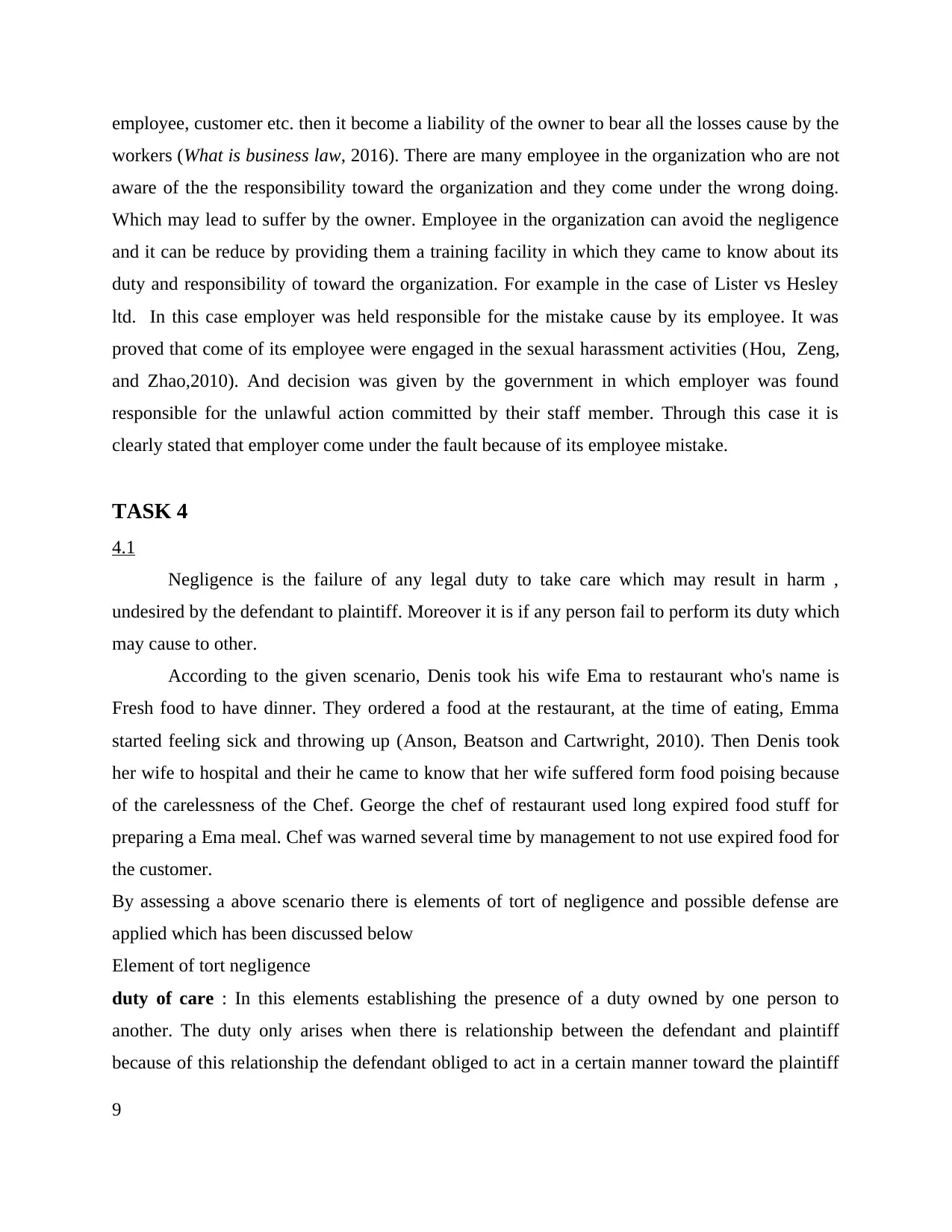
employee, customer etc. then it become a liability of the owner to bear all the losses cause by the
workers (What is business law, 2016). There are many employee in the organization who are not
aware of the the responsibility toward the organization and they come under the wrong doing.
Which may lead to suffer by the owner. Employee in the organization can avoid the negligence
and it can be reduce by providing them a training facility in which they came to know about its
duty and responsibility of toward the organization. For example in the case of Lister vs Hesley
ltd. In this case employer was held responsible for the mistake cause by its employee. It was
proved that come of its employee were engaged in the sexual harassment activities (Hou, Zeng,
and Zhao,2010). And decision was given by the government in which employer was found
responsible for the unlawful action committed by their staff member. Through this case it is
clearly stated that employer come under the fault because of its employee mistake.
TASK 4
4.1
Negligence is the failure of any legal duty to take care which may result in harm ,
undesired by the defendant to plaintiff. Moreover it is if any person fail to perform its duty which
may cause to other.
According to the given scenario, Denis took his wife Ema to restaurant who's name is
Fresh food to have dinner. They ordered a food at the restaurant, at the time of eating, Emma
started feeling sick and throwing up (Anson, Beatson and Cartwright, 2010). Then Denis took
her wife to hospital and their he came to know that her wife suffered form food poising because
of the carelessness of the Chef. George the chef of restaurant used long expired food stuff for
preparing a Ema meal. Chef was warned several time by management to not use expired food for
the customer.
By assessing a above scenario there is elements of tort of negligence and possible defense are
applied which has been discussed below
Element of tort negligence
duty of care : In this elements establishing the presence of a duty owned by one person to
another. The duty only arises when there is relationship between the defendant and plaintiff
because of this relationship the defendant obliged to act in a certain manner toward the plaintiff
9
workers (What is business law, 2016). There are many employee in the organization who are not
aware of the the responsibility toward the organization and they come under the wrong doing.
Which may lead to suffer by the owner. Employee in the organization can avoid the negligence
and it can be reduce by providing them a training facility in which they came to know about its
duty and responsibility of toward the organization. For example in the case of Lister vs Hesley
ltd. In this case employer was held responsible for the mistake cause by its employee. It was
proved that come of its employee were engaged in the sexual harassment activities (Hou, Zeng,
and Zhao,2010). And decision was given by the government in which employer was found
responsible for the unlawful action committed by their staff member. Through this case it is
clearly stated that employer come under the fault because of its employee mistake.
TASK 4
4.1
Negligence is the failure of any legal duty to take care which may result in harm ,
undesired by the defendant to plaintiff. Moreover it is if any person fail to perform its duty which
may cause to other.
According to the given scenario, Denis took his wife Ema to restaurant who's name is
Fresh food to have dinner. They ordered a food at the restaurant, at the time of eating, Emma
started feeling sick and throwing up (Anson, Beatson and Cartwright, 2010). Then Denis took
her wife to hospital and their he came to know that her wife suffered form food poising because
of the carelessness of the Chef. George the chef of restaurant used long expired food stuff for
preparing a Ema meal. Chef was warned several time by management to not use expired food for
the customer.
By assessing a above scenario there is elements of tort of negligence and possible defense are
applied which has been discussed below
Element of tort negligence
duty of care : In this elements establishing the presence of a duty owned by one person to
another. The duty only arises when there is relationship between the defendant and plaintiff
because of this relationship the defendant obliged to act in a certain manner toward the plaintiff
9
⊘ This is a preview!⊘
Do you want full access?
Subscribe today to unlock all pages.

Trusted by 1+ million students worldwide
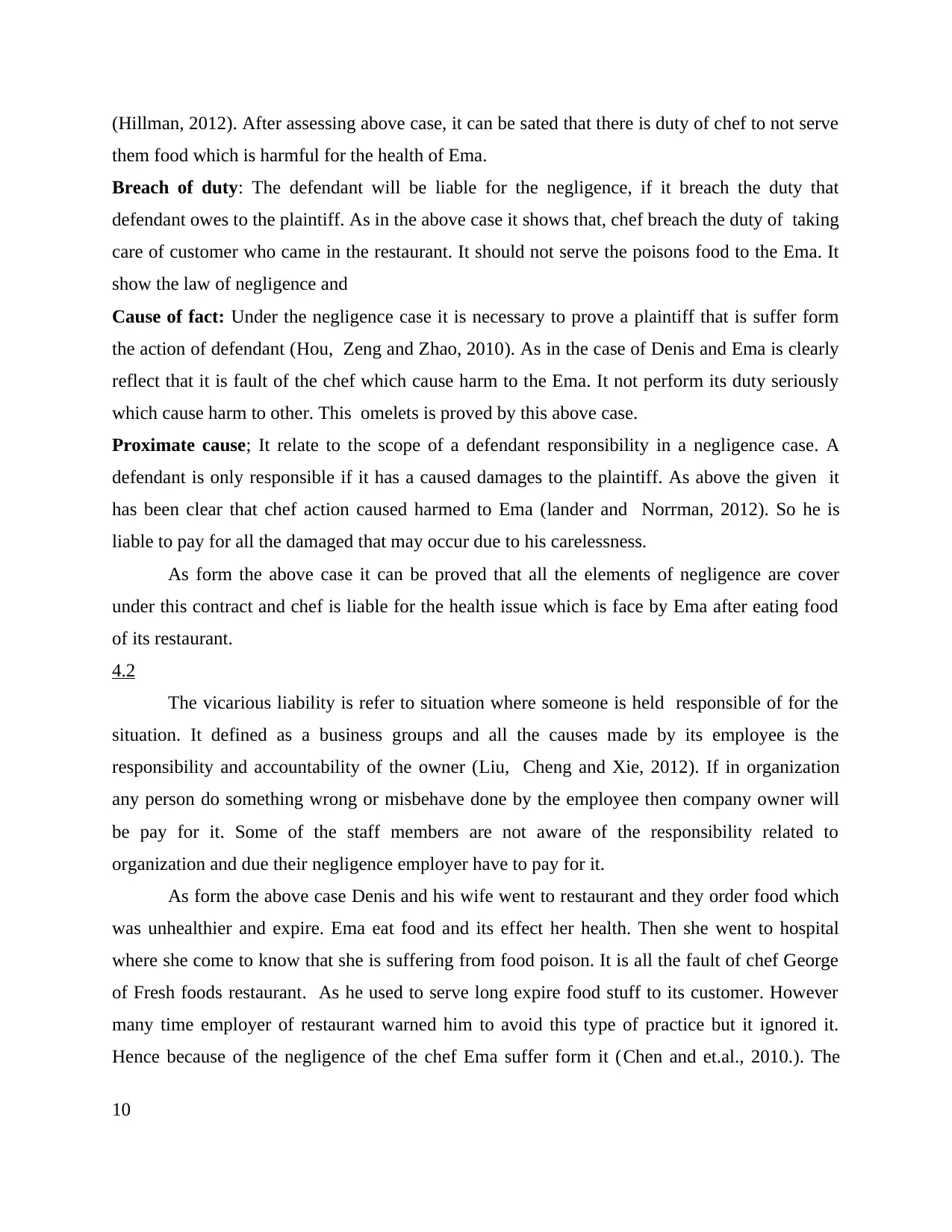
(Hillman, 2012). After assessing above case, it can be sated that there is duty of chef to not serve
them food which is harmful for the health of Ema.
Breach of duty: The defendant will be liable for the negligence, if it breach the duty that
defendant owes to the plaintiff. As in the above case it shows that, chef breach the duty of taking
care of customer who came in the restaurant. It should not serve the poisons food to the Ema. It
show the law of negligence and
Cause of fact: Under the negligence case it is necessary to prove a plaintiff that is suffer form
the action of defendant (Hou, Zeng and Zhao, 2010). As in the case of Denis and Ema is clearly
reflect that it is fault of the chef which cause harm to the Ema. It not perform its duty seriously
which cause harm to other. This omelets is proved by this above case.
Proximate cause; It relate to the scope of a defendant responsibility in a negligence case. A
defendant is only responsible if it has a caused damages to the plaintiff. As above the given it
has been clear that chef action caused harmed to Ema (lander and Norrman, 2012). So he is
liable to pay for all the damaged that may occur due to his carelessness.
As form the above case it can be proved that all the elements of negligence are cover
under this contract and chef is liable for the health issue which is face by Ema after eating food
of its restaurant.
4.2
The vicarious liability is refer to situation where someone is held responsible of for the
situation. It defined as a business groups and all the causes made by its employee is the
responsibility and accountability of the owner (Liu, Cheng and Xie, 2012). If in organization
any person do something wrong or misbehave done by the employee then company owner will
be pay for it. Some of the staff members are not aware of the responsibility related to
organization and due their negligence employer have to pay for it.
As form the above case Denis and his wife went to restaurant and they order food which
was unhealthier and expire. Ema eat food and its effect her health. Then she went to hospital
where she come to know that she is suffering from food poison. It is all the fault of chef George
of Fresh foods restaurant. As he used to serve long expire food stuff to its customer. However
many time employer of restaurant warned him to avoid this type of practice but it ignored it.
Hence because of the negligence of the chef Ema suffer form it (Chen and et.al., 2010.). The
10
them food which is harmful for the health of Ema.
Breach of duty: The defendant will be liable for the negligence, if it breach the duty that
defendant owes to the plaintiff. As in the above case it shows that, chef breach the duty of taking
care of customer who came in the restaurant. It should not serve the poisons food to the Ema. It
show the law of negligence and
Cause of fact: Under the negligence case it is necessary to prove a plaintiff that is suffer form
the action of defendant (Hou, Zeng and Zhao, 2010). As in the case of Denis and Ema is clearly
reflect that it is fault of the chef which cause harm to the Ema. It not perform its duty seriously
which cause harm to other. This omelets is proved by this above case.
Proximate cause; It relate to the scope of a defendant responsibility in a negligence case. A
defendant is only responsible if it has a caused damages to the plaintiff. As above the given it
has been clear that chef action caused harmed to Ema (lander and Norrman, 2012). So he is
liable to pay for all the damaged that may occur due to his carelessness.
As form the above case it can be proved that all the elements of negligence are cover
under this contract and chef is liable for the health issue which is face by Ema after eating food
of its restaurant.
4.2
The vicarious liability is refer to situation where someone is held responsible of for the
situation. It defined as a business groups and all the causes made by its employee is the
responsibility and accountability of the owner (Liu, Cheng and Xie, 2012). If in organization
any person do something wrong or misbehave done by the employee then company owner will
be pay for it. Some of the staff members are not aware of the responsibility related to
organization and due their negligence employer have to pay for it.
As form the above case Denis and his wife went to restaurant and they order food which
was unhealthier and expire. Ema eat food and its effect her health. Then she went to hospital
where she come to know that she is suffering from food poison. It is all the fault of chef George
of Fresh foods restaurant. As he used to serve long expire food stuff to its customer. However
many time employer of restaurant warned him to avoid this type of practice but it ignored it.
Hence because of the negligence of the chef Ema suffer form it (Chen and et.al., 2010.). The
10
Paraphrase This Document
Need a fresh take? Get an instant paraphrase of this document with our AI Paraphraser
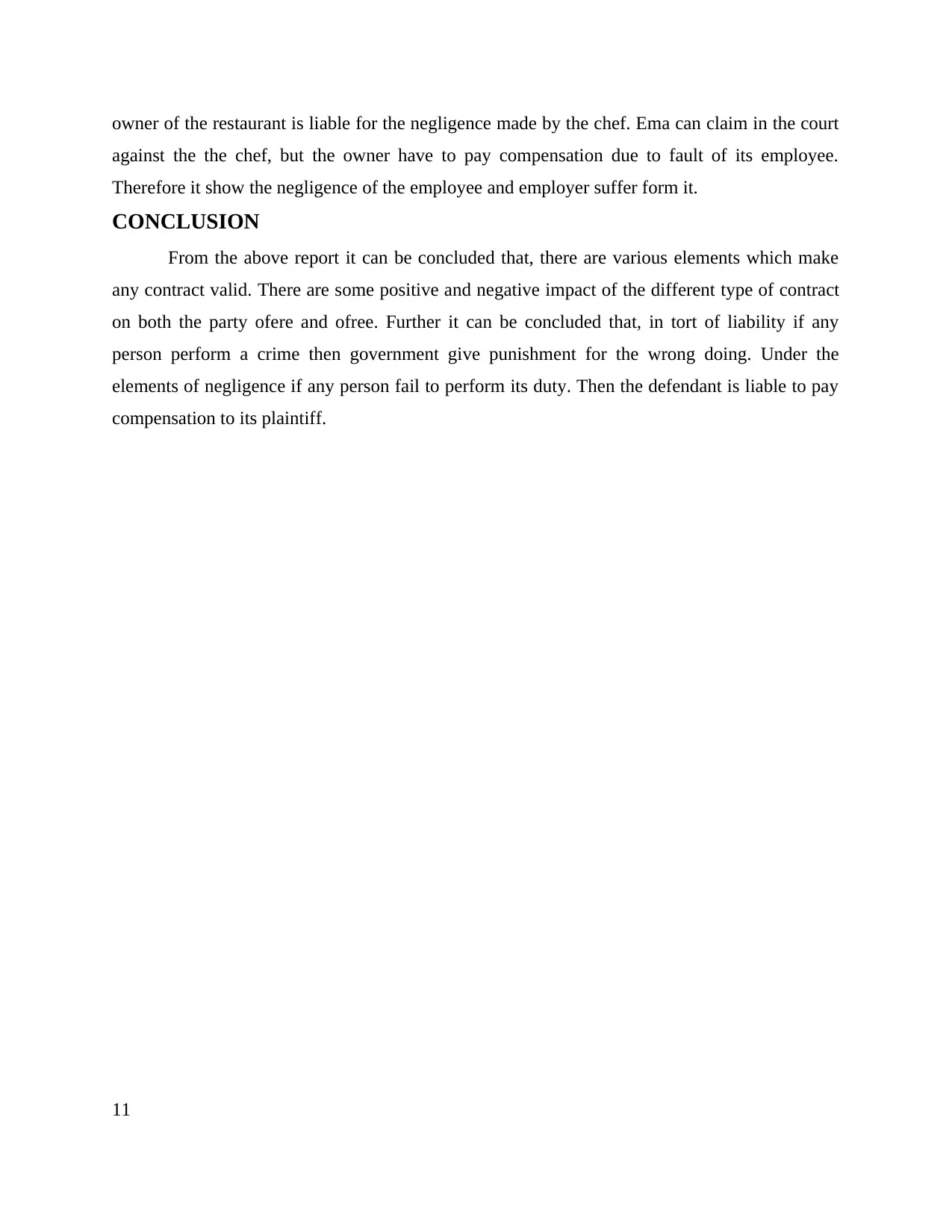
owner of the restaurant is liable for the negligence made by the chef. Ema can claim in the court
against the the chef, but the owner have to pay compensation due to fault of its employee.
Therefore it show the negligence of the employee and employer suffer form it.
CONCLUSION
From the above report it can be concluded that, there are various elements which make
any contract valid. There are some positive and negative impact of the different type of contract
on both the party ofere and ofree. Further it can be concluded that, in tort of liability if any
person perform a crime then government give punishment for the wrong doing. Under the
elements of negligence if any person fail to perform its duty. Then the defendant is liable to pay
compensation to its plaintiff.
11
against the the chef, but the owner have to pay compensation due to fault of its employee.
Therefore it show the negligence of the employee and employer suffer form it.
CONCLUSION
From the above report it can be concluded that, there are various elements which make
any contract valid. There are some positive and negative impact of the different type of contract
on both the party ofere and ofree. Further it can be concluded that, in tort of liability if any
person perform a crime then government give punishment for the wrong doing. Under the
elements of negligence if any person fail to perform its duty. Then the defendant is liable to pay
compensation to its plaintiff.
11
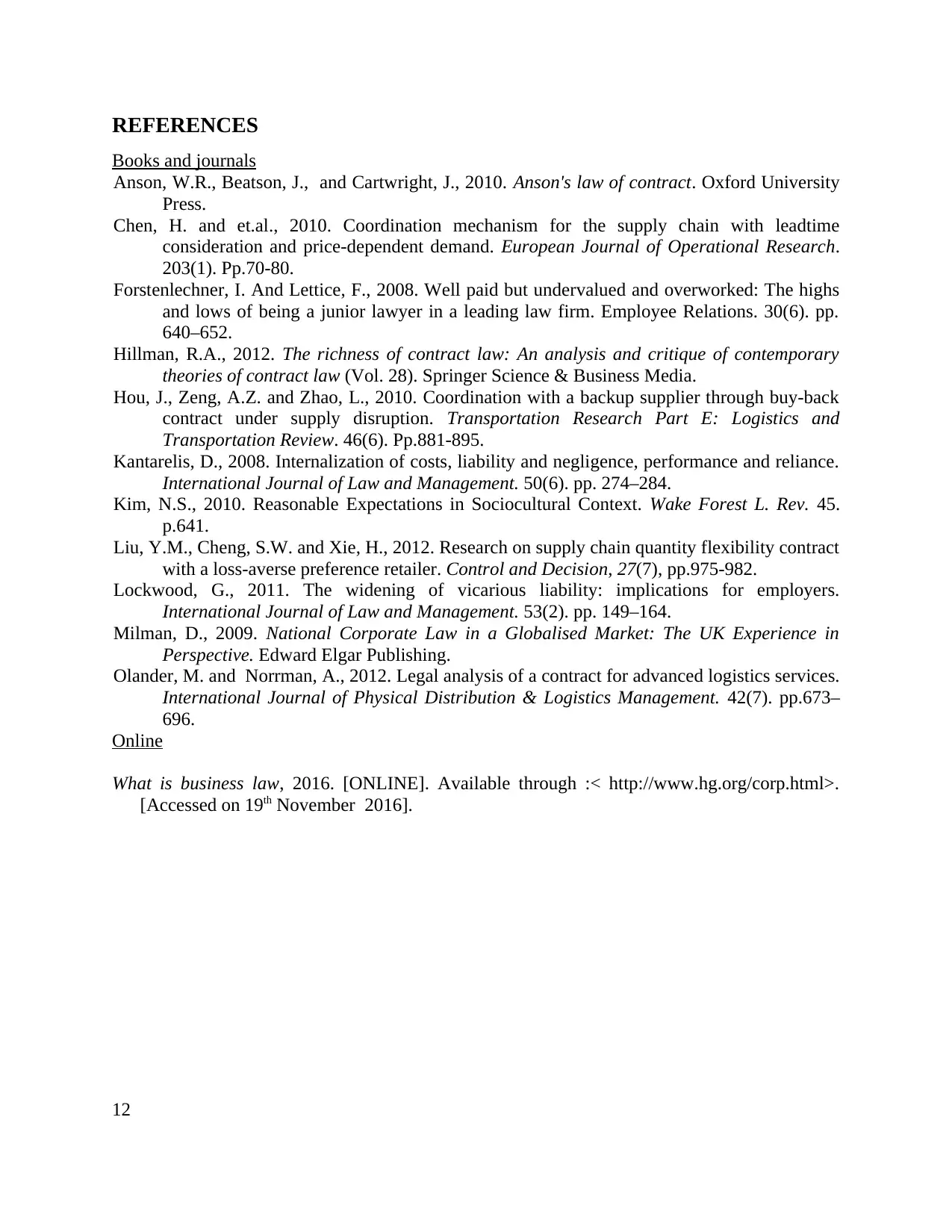
REFERENCES
Books and journals
Anson, W.R., Beatson, J., and Cartwright, J., 2010. Anson's law of contract. Oxford University
Press.
Chen, H. and et.al., 2010. Coordination mechanism for the supply chain with leadtime
consideration and price-dependent demand. European Journal of Operational Research.
203(1). Pp.70-80.
Forstenlechner, I. And Lettice, F., 2008. Well paid but undervalued and overworked: The highs
and lows of being a junior lawyer in a leading law firm. Employee Relations. 30(6). pp.
640–652.
Hillman, R.A., 2012. The richness of contract law: An analysis and critique of contemporary
theories of contract law (Vol. 28). Springer Science & Business Media.
Hou, J., Zeng, A.Z. and Zhao, L., 2010. Coordination with a backup supplier through buy-back
contract under supply disruption. Transportation Research Part E: Logistics and
Transportation Review. 46(6). Pp.881-895.
Kantarelis, D., 2008. Internalization of costs, liability and negligence, performance and reliance.
International Journal of Law and Management. 50(6). pp. 274–284.
Kim, N.S., 2010. Reasonable Expectations in Sociocultural Context. Wake Forest L. Rev. 45.
p.641.
Liu, Y.M., Cheng, S.W. and Xie, H., 2012. Research on supply chain quantity flexibility contract
with a loss-averse preference retailer. Control and Decision, 27(7), pp.975-982.
Lockwood, G., 2011. The widening of vicarious liability: implications for employers.
International Journal of Law and Management. 53(2). pp. 149–164.
Milman, D., 2009. National Corporate Law in a Globalised Market: The UK Experience in
Perspective. Edward Elgar Publishing.
Olander, M. and Norrman, A., 2012. Legal analysis of a contract for advanced logistics services.
International Journal of Physical Distribution & Logistics Management. 42(7). pp.673–
696.
Online
What is business law, 2016. [ONLINE]. Available through :< http://www.hg.org/corp.html>.
[Accessed on 19th November 2016].
12
Books and journals
Anson, W.R., Beatson, J., and Cartwright, J., 2010. Anson's law of contract. Oxford University
Press.
Chen, H. and et.al., 2010. Coordination mechanism for the supply chain with leadtime
consideration and price-dependent demand. European Journal of Operational Research.
203(1). Pp.70-80.
Forstenlechner, I. And Lettice, F., 2008. Well paid but undervalued and overworked: The highs
and lows of being a junior lawyer in a leading law firm. Employee Relations. 30(6). pp.
640–652.
Hillman, R.A., 2012. The richness of contract law: An analysis and critique of contemporary
theories of contract law (Vol. 28). Springer Science & Business Media.
Hou, J., Zeng, A.Z. and Zhao, L., 2010. Coordination with a backup supplier through buy-back
contract under supply disruption. Transportation Research Part E: Logistics and
Transportation Review. 46(6). Pp.881-895.
Kantarelis, D., 2008. Internalization of costs, liability and negligence, performance and reliance.
International Journal of Law and Management. 50(6). pp. 274–284.
Kim, N.S., 2010. Reasonable Expectations in Sociocultural Context. Wake Forest L. Rev. 45.
p.641.
Liu, Y.M., Cheng, S.W. and Xie, H., 2012. Research on supply chain quantity flexibility contract
with a loss-averse preference retailer. Control and Decision, 27(7), pp.975-982.
Lockwood, G., 2011. The widening of vicarious liability: implications for employers.
International Journal of Law and Management. 53(2). pp. 149–164.
Milman, D., 2009. National Corporate Law in a Globalised Market: The UK Experience in
Perspective. Edward Elgar Publishing.
Olander, M. and Norrman, A., 2012. Legal analysis of a contract for advanced logistics services.
International Journal of Physical Distribution & Logistics Management. 42(7). pp.673–
696.
Online
What is business law, 2016. [ONLINE]. Available through :< http://www.hg.org/corp.html>.
[Accessed on 19th November 2016].
12
⊘ This is a preview!⊘
Do you want full access?
Subscribe today to unlock all pages.

Trusted by 1+ million students worldwide
1 out of 12
Related Documents
Your All-in-One AI-Powered Toolkit for Academic Success.
+13062052269
info@desklib.com
Available 24*7 on WhatsApp / Email
![[object Object]](/_next/static/media/star-bottom.7253800d.svg)
Unlock your academic potential
Copyright © 2020–2025 A2Z Services. All Rights Reserved. Developed and managed by ZUCOL.





